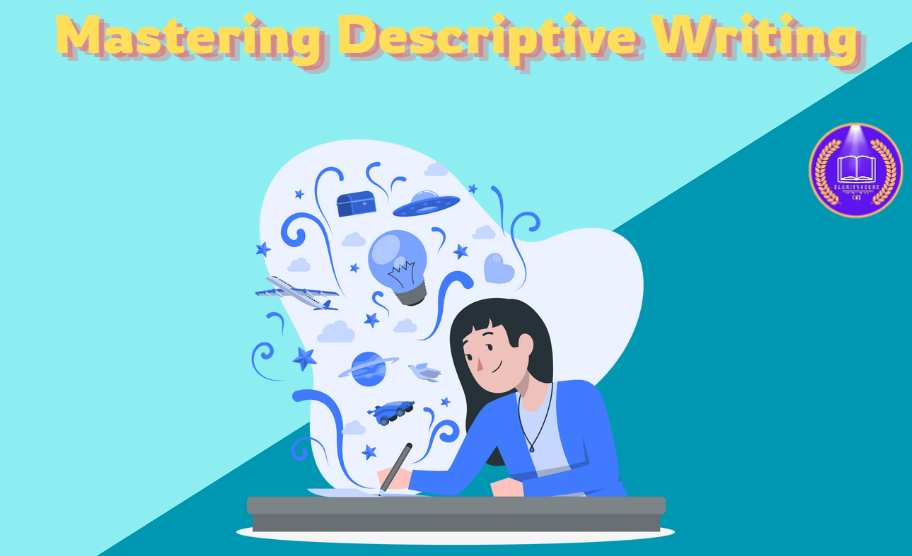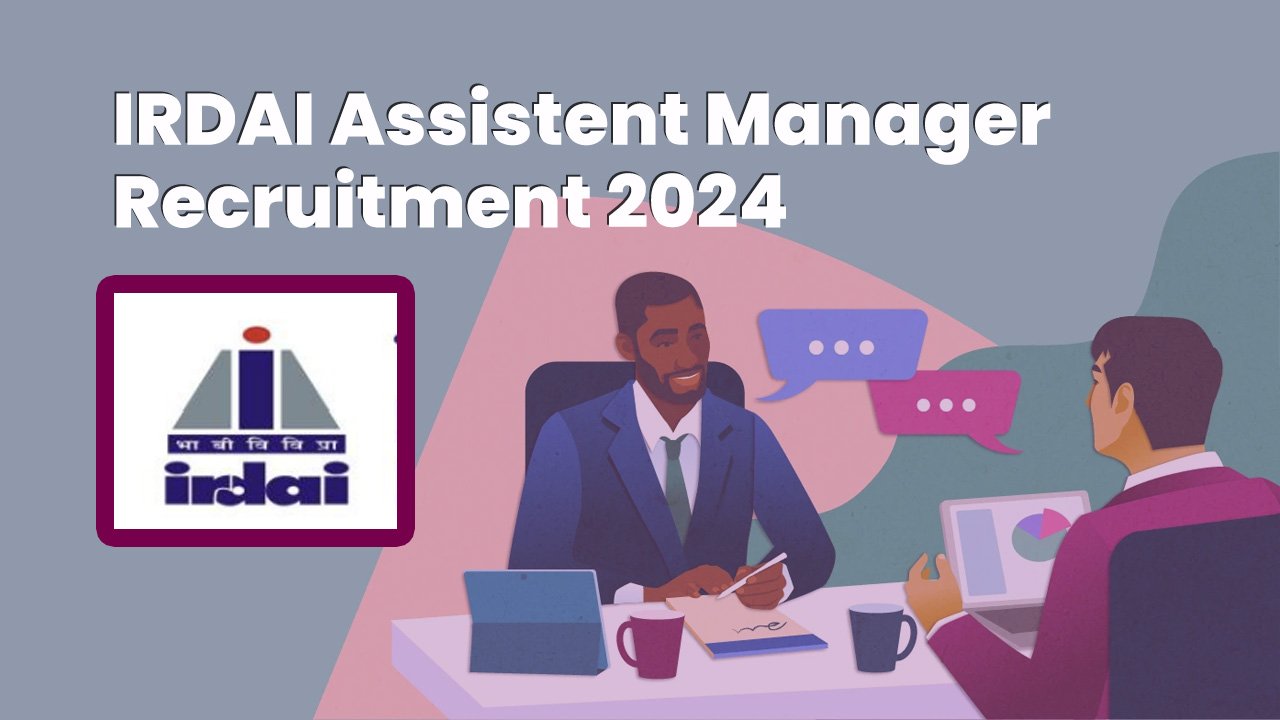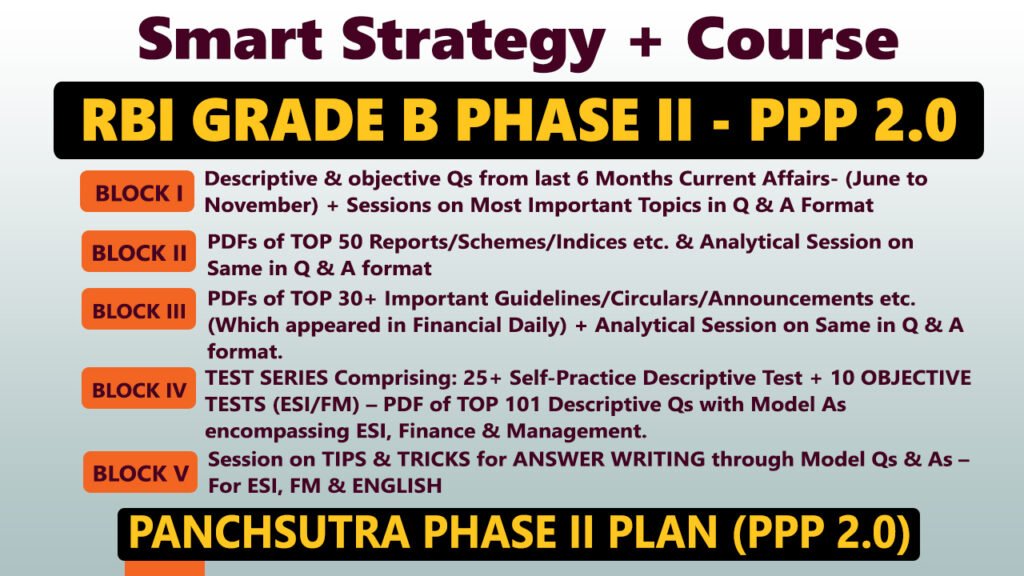RBI Grade B Stage II English Descriptive Previous Year Questions and Model Answer 2024

| Section | Details |
|---|---|
| Essay (40 Marks) | Write a 550-600 word essay on one of the given topics. |
| Precis (30 Marks) | Write a precis in 180-200 words. |
| Reading Comprehension (30 Marks) | Answer 6 questions based on the passage, with each answer being 50-60 words long. |
| Essay Topics | 1. How does climate change impact global migration, and what are the effects on both origin and destination countries? 2. How can an organization foster employees’ well-being by prioritizing mental health for overall success? 3. Discuss the social, economic, and environmental impacts of hosting the Olympics in India. 4. “Anyone who stops learning is old, whether at 20 or 80. Anyone who keeps learning stays young. The greatest thing in your life is to keep your mind young.” Elaborate. |
| Passage Topics for Precis | 1. Can AI replace a CEO in an organization in the near future? |
| Reading comprehension | 1. Customer-Relationship Management and its effect on sales |
Model Answer, word limit, pattern and Previous Year cutoff for RBI Phase II English descriptive question
01. Pattern of Exam for RBI grade B English descriptive phase 2 online exam
| Exam | Mode | Paper | Type of Paper | No. of Questions | Duration | Weightage | Marks |
|---|---|---|---|---|---|---|---|
| Paper 2 | Online (Typed using Keyboard) | General English | Descriptive | 3 | 90 minutes | 33% | 100 |
02. Word Limit for RBI Grade B English descriptive online paper phase II
| Section | Word Limit | Marks | Details |
|---|---|---|---|
| Essay | 600 words | 40 marks | Comprehensive essay on a given topic |
| Precis | 180-200 words | 30 marks | Summarizing a passage concisely |
| Reading Comprehension | 5-6 questions (50-60 words each) | 30 marks (5-6 marks each) | Based on a provided passage |
03. Cutoff of RBI grade B exam English descriptive phase 2 for 2023
Aggregate cutoff marks to qualify for interview round. There is no separate cutoff for English but aggregate cutoff to of all three paper to get a call for interview
Here’s the table for your data presented in a clear and structured format:
| Recruitment Stage | Category | General | OBC | SC | ST | EWS | PwBD |
|---|---|---|---|---|---|---|---|
| Aggregate cut-off marks in Paper-I, II, and III (out of 300) | Cut-off Marks | 169.00 | 169.00 | 156.50 | 148.50 | 169.00 | 148.00 |
| Aggregate marks in Paper-I, II, III, and Interview (out of 375) obtained by the last recommended candidate | General | 229.00 | 221.75 | 213.75 | 203.25 | 194.00 | 202.75 (GEN) 167.75 (EWS) No PwBD Candidate qualified in SC, ST and OBC category |
Important Note: As of now, the RBI Grade B 2024 interviews are already over and results are awaited. RBI usually releases the cut-offs for Phase 2 and final selection after the completion of the entire recruitment process for the 2024 cycle.
04. Model Answers
Essay questions asked in RBI grade B English descriptive phase 2 online exam 2024
The length of model answers is more with a greater number of points which will help you to have better idea for the topic and write accordingly as per your need
- How does climate change impact global migration, and what are the effects on both origin and destination countries?
- How can an organization foster employees well- being by prioritizing mental health for overall success?
- Discuss the social, economic and environmental impacts of hosting Olympics in India.
- “Anyone who stops learning is old, whether at 20 or 80. Anyone who keeps learning stays young. The greatest thing in your life is to keep your mind young”. Elaborate
Question and Answer Section
1.How does climate change impact global migration, and what are the effects on both origin and destination countries?
Introduction:
Climate change has emerged as a significant driver of global migration, reshaping patterns of human movement and exerting profound effects on both origin and destination countries. The interplay between environmental changes, socio-economic conditions, and migration decisions illustrates the complex and multifaceted nature of this phenomenon.
As early as 1990 the Intergovernmental Panel on Climate Change (IPCC) noted that the greatest single impact of climate change might be on human migration—with millions of people displaced by shoreline erosion, coastal flooding and agricultural disruption. Since then, successive reports have argued that environmental degradation, and in particular climate change, is poised to become a major driver of population displacement—a crisis in the making.
Professor Myers’ estimate of 200 million climate migrants by 2050 has become the accepted figure—cited in respected publications from the IPCC to the Stern Review on the Economics of Climate Change.
Climate Change as a Driver of Migration
Climate change influences migration through two primary pathways:
Extreme Weather Events
Disasters like heat waves, droughts, floods, and wildfires cause short-term population displacement
The impact of climate change as a driver of future forced migration depends on several factors:
- the quantity of future greenhouse gas emissions,
- the rate of future population growth and distribution,
- the meteorological evolution of climate change,
- the effectiveness of local and national adaptation strategies.
In 2017, extreme weather displaced 18.8 million people across 135 countries decreased agricultural productivity incentivizes urban or international migration potential for economic transformation through migration
Climate change influences migration through a variety of pathways:
- Environmental Displacement: Rising sea levels, desertification, extreme weather events, and resource scarcity compel individuals to leave their homes within 1000 km of origin. For example, communities in low-lying island nations and coastal regions face existential threats due to flooding and erosion.
By 2099 the world is expected to be on average between 1.8ºC and 4ºC hotter than it is now. Large areas are expected to become drier—the proportion of land in constant drought expected to increase from 2 per cent to 10 per cent by 2050.Meanwhile, the proportion of land suffering extreme drought is predicted to increase from 1 per cent at present to 0 per cent by the end of the 21st century. - Economic Instability: Changes in climate disrupt agricultural production, leading to food insecurity and loss of livelihoods and can trap populations in poverty. Rural populations, particularly in developing countries, are often forced to migrate in search of alternative income sources.
- Conflict and Social Unrest: Competition over dwindling resources, such as water and arable land, can exacerbate tensions and fuel conflict, prompting forced migration to wealthy OECD countries.
- Gradual vs. Sudden Impact: While sudden disasters, such as hurricanes, lead to immediate displacement, slow-onset changes, like prolonged droughts, push people to migrate over time.
Less rain would have particularly serious impacts for sub-Saharan African agriculture which is largely rain-fed: the 2007 IPCC report of the Second Working Group estimates that yields from rain-fed agriculture could fall by up to 50 per cent by 2020.
The departure of individuals due to climate change leaves profound effects on their home regions:
The World Bank estimates regions like Latin America, South Asia and Sub-Saharan Africa
could produce 143 million internal climate migrants by 2050.
- Economic Impact: The loss of working-age populations can reduce productivity and hinder economic development. However, remittances sent by migrants may provide financial support to families and communities left behind.
- Social Consequences: The departure of large segments of the population, especially younger generations, disrupts community structures and exacerbates demographic imbalances.
- Environmental Degradation: Migration itself does not resolve underlying environmental issues, leaving origin areas vulnerable to further degradation and crises.
Effects on Destination Countries
Countries receiving climate migrants face their own set of challenges and opportunities:
- Economic Integration: Migrants may fill labour shortages and contribute to economic growth. However, sudden influxes can strain infrastructure, housing, and public services.
- Social and Cultural Tensions: The arrival of migrants can lead to cultural integration challenges, xenophobia, and political tensions, particularly if resources are perceived as scarce.
- Policy Implications: Destination countries must adapt by implementing policies that promote sustainable urban development and support for incoming populations, while addressing environmental concerns.
Global Implications
The relationship between climate change and migration transcends national borders, necessitating international cooperation:
- Climate Refugee Protections: Current international frameworks do not fully recognize climate refugees, leaving many without legal status or protection. Expanding legal definitions and support mechanisms is critical.
- Sustainable Development: Addressing the root causes of climate-induced migration, such as reducing greenhouse gas emissions and investing in climate-resilient infrastructure, can mitigate displacement.
- Equitable Solutions: Wealthier nations, which have historically contributed the most to climate change, bear a moral responsibility to assist vulnerable populations and region
Government Initiatives Regarding Migration
- Initiatives like the draft national migrant labour policy prepared by NITI Ayog in 2021 discuss the importance of collective action to help migrants bargain for better conditions.
- Additionally, the One Nation One Ration Card Project (ONORC) has been expanded, along with the introduction of the Affordable Rental Housing Complexes (ARHC) and the PM Garib Kalyan Yojna scheme.
- The launch of the E-Sham portal also brings promise to the migrant’s status.
- The code on Social Security provides certain benefits for inter-state migrant workers such as Insurance and provident fund.
- In 2016 the United Nations General Assembly convened a high-level plenary meeting on addressing large movements of refugees and prepared the report “Safety and Dignity: Addressing Large Movements of Refugees and Migrants”.
India’s Climate Change Mitigation Initiatives
- National Action Plan on Climate Change (NAPCC)
- Nationally Determined Contributions (NDC)
- National Adaptation Fund on Climate Change (NAFCC)
- State Action Plan on Climate Change (SAPCC)
Conclusion
Climate change is reshaping migration patterns and posing challenges that require a comprehensive, multi-level response. Both origin and destination countries face unique effects, from economic and demographic shifts to social and environmental challenges. Addressing these issues demands proactive policies that combine climate mitigation, adaptation strategies, and support for displaced populations. Only through global cooperation and sustainable development can humanity effectively manage the complex interplay between climate change and migration.
PYQ
- Discuss the changes in the trends of labor migration within and outside India in the last four decades. (2015) UPSC
- Discuss the challenges and policy implications of climate migration in India. How can the government ensure the protection and welfare of climate migrants while addressing the environmental concerns that drive migration?
2. How can an organization foster employees well- being by prioritizing mental health for overall success?
Introduction
The theme of World Mental Health Day (October 10) 2023 is ‘mental health as a universal human right’. A segment often overlooked when it concerns mental health is the informal worker. A study by the International Labour Organization (ILO) says that 15% of working-age adults, globally, live with a mental disorder. Companies with high levels of employee engagement are 22% more profitable than low levels of employee engagement.
In today’s fast-paced and competitive work environment, the mental health of employees has become an essential component of organizational success. An organization that prioritizes mental health fosters a culture of care, boosts employee satisfaction, and ultimately enhances overall productivity. Addressing mental health not only helps individuals lead healthier lives but also creates a positive work environment that benefits the entire organization. This essay explores the importance of prioritizing mental health and offers strategies for fostering employee well-being.
The Importance of Mental Health in the Workplace
Mental health significantly influences employee performance, decision-making, and interpersonal relationships. Poor mental health can lead to absenteeism, reduced productivity, and high turnover rates, costing organizations both financially and operationally. Conversely, employees who feel supported and valued tend to be more engaged, innovative, and resilient. By addressing mental health, organizations demonstrate a commitment to their workforce, which fosters loyalty and strengthens their reputation as an employer of choice.
Strategies to Foster Employee Well-Being
- Creating a Supportive Culture
A culture of openness and acceptance around mental health is fundamental. Organizations can achieve this by encouraging dialogue, challenging stigma, and promoting awareness. Leadership should lead by example, openly discussing mental health and demonstrating a commitment to supporting employees in need. - Implementing Comprehensive Mental Health Programs
Offering resources such as Employee Assistance Programs (EAPs), counselling services, and mental health workshops provides employees with tools to manage stress and seek help when needed. Regularly assessing the effectiveness of these programs ensures they meet employee needs and align with organizational goals. - Promoting Work-Life Balance
A healthy work-life balance is crucial for mental well-being. Flexible working hours, remote work options, and encouraging employees to take breaks can reduce burnout. Ensuring workloads are manageable and respecting personal time fosters a more balanced and productive workforce. - Training for Managers and Leaders
Managers play a key role in identifying and addressing mental health challenges among team members. Providing training on recognizing signs of stress, anxiety, or depression equips them to respond effectively. Compassionate leadership helps build trust and creates a supportive environment. - Creating Safe Physical and Digital Spaces
A workplace that promotes mental well-being includes comfortable physical spaces and digital platforms that enable collaboration without overwhelming employees. Providing quiet rooms, ergonomic workstations, and tools for managing digital overload can significantly enhance well-being. - Recognizing and Rewarding Contributions
Recognizing employees’ efforts and achievements boosts morale and self-worth. Regular feedback, rewards, and opportunities for growth show that the organization values its employees, which can improve mental health and job satisfaction.
The Benefits of Prioritizing Mental Health
Organizations that prioritize mental health reap multiple benefits. Employees are more motivated and productive, leading to higher efficiency and innovation. Reduced absenteeism and turnover rates lower recruitment and training costs. Additionally, a mentally healthy workforce enhances the organization’s image, attracting top talent and increasing customer trust.
Steps Taken by the Government:
- National Mental Health Program (NMHP): The National Mental Health Program (NMHP) was adopted by the government in 1982 in response to the large number of mental disorders and shortage of mental health professionals.
- District Mental Health Programme (DMHP), 1996 was also launched to provide community mental health services at the primary health care level.
- Mental Health Act: As part of the Mental Health Care Act 2017, every affected person has access to mental healthcare and treatment from government institutions.
- It has significantly reduced the significance of Section 309 IPC and attempts to commit suicide are punishable only as exceptions.
- Kiran Helpline: In 2020, the Ministry of Social Justice and Empowerment launched a 24/7 toll-free helpline ‘Kiran’ to provide mental health support.
- Mano Darpan Initiative: It aimed at providing psychosocial support to students, teachers, and family members during the Covid-19 pandemic.
- MANAS Mobile App: To promote mental wellbeing across age groups, the Government of India launched MANAS (Mental Health and Normalcy Augmentation System) in 2021.
Conclusion
The mental health and well-being of employees are pivotal to organizational success and should be treated as a priority rather than an afterthought. Fostering employee well-being by prioritizing mental health is not merely a moral obligation but also a strategic advantage for organizations. By creating a supportive culture, offering mental health resources, promoting work-life balance, and training leaders, organizations can nurture a healthy and productive workforce. Investing in mental health is an investment in the organization’s future, ensuring sustainability, resilience, and success in a competitive world. It is time for employers to recognize that investing in mental health is an investment in their greatest asset: their people.
3. Discuss the social, economic and environmental impacts of hosting Olympics in India
The Olympics is more than just a sporting event; it is a global celebration of unity, excellence, and culture. For a country like India, hosting the Olympics would bring transformative changes, not just in sports but also in social, economic, and environmental domains. While the challenges of hosting an event of this magnitude are significant, the benefits can be equally monumental, paving the way for long-term growth and development.
Social Benefits
- National Pride and Unity
Hosting the Olympics can foster a sense of pride and unity among citizens. As the world’s largest democracy with a diverse population, the event would bring people together to celebrate Indian culture, traditions, and achievements on a global stage. - Sports Development
An Olympics in India would create opportunities to improve infrastructure, identify young talent, and enhance the sports ecosystem. It could inspire millions of children to pursue sports, fostering a culture of physical fitness and excellence. - Global Cultural Exchange
The Olympics would showcase India’s rich cultural heritage to the world. Visitors and participants would experience India’s traditions, cuisine, and hospitality, enhancing the country’s global image. - Youth Empowerment
Hosting the Olympics would generate numerous opportunities for young people, from volunteering to internships, enhancing skills and employability.
Economic Benefits
- Boost to Infrastructure Development
Preparing for the Olympics would require substantial investments in infrastructure, such as stadiums, transportation systems, and urban development. These improvements would benefit the economy long after the games are over. - Tourism Growth
An event of this scale would attract millions of international visitors, boosting tourism and related industries such as hospitality, retail, and transportation. The global exposure could position India as a top tourist destination. - Job Creation
The construction, operation, and management of Olympic facilities would create thousands of jobs, directly and indirectly. From skilled labor to service roles, a wide range of employment opportunities would emerge. - Economic Stimulus
The influx of investments, sponsorships, and foreign visitors would stimulate the economy, providing a ripple effect across various sectors. - Global Business Opportunities
Hosting the Olympics would place India on the global economic map, attracting foreign direct investments (FDIs) and fostering partnerships with international companies.
Environmental Benefits
- Sustainable Infrastructure
Hosting the Olympics would encourage the construction of green buildings and eco-friendly sports facilities. India could adopt energy-efficient technologies, renewable energy sources, and sustainable practices that set a precedent for future development. - Urban Green Spaces
Preparations for the Olympics often include the development of parks, green belts, and open spaces, improving urban living conditions and air quality. - Improved Waste Management
The focus on environmental responsibility during the games could lead to advancements in waste management systems, recycling programs, and reduced single-use plastics. - Public Awareness
Hosting an eco-friendly Olympics would raise awareness about environmental sustainability among citizens, encouraging them to adopt greener lifestyles.
Challenges and Considerations
While the benefits are numerous, hosting the Olympics is not without challenges. It requires substantial investments, careful planning, and a focus on minimizing social and environmental disruptions. To maximize the benefits, India must ensure transparency, prioritize sustainability, and involve local communities in decision-making processes.
Conclusion
Hosting the Olympics in India would be a transformative opportunity with far-reaching social, economic, and environmental benefits. By uniting people, boosting the economy, and promoting sustainability, it would position India as a global leader in innovation, culture, and progress. While the road to hosting the Olympics is arduous, the legacy it leaves behind could redefine India’s global standing and inspire generations to come.
4. “Anyone who stops learning is old, whether at 20 or 80. Anyone who keeps learning stays young. The greatest thing in your life is to keep your mind young”. Elaborate
The quote highlights the timeless value of continuous learning and intellectual curiosity in maintaining vitality and relevance throughout life. It emphasizes that age is not merely a measure of years but a reflection of one’s mindset and willingness to grow.
The Essence of Lifelong Learning
Learning is a dynamic process that fuels personal and intellectual growth. It keeps the mind active, curious, and adaptable, enabling individuals to embrace new experiences and ideas. Stopping the pursuit of knowledge, on the other hand, can lead to stagnation and a rigid outlook on life, regardless of chronological age. In this sense, learning becomes a tool for staying young at heart and maintaining enthusiasm for life.
Breaking the Myth of Aging
The quote challenges the traditional notion of aging as merely a physical process. It suggests that a young mind is not bound by age but by an attitude of openness and adaptability. For instance, an 80-year-old who learns to use new technology, reads widely, or takes up a new skill often exhibits the same vibrancy as someone decades younger. Conversely, a 20-year-old who resists change and avoids learning may appear “old” in their mindset.
Benefits of Keeping the Mind Young
- Mental Agility and Cognitive Health:
Continuous learning stimulates the brain, enhancing memory, problem-solving, and creativity. Studies show that intellectual engagement can delay cognitive decline, making lifelong learning a key to mental health. - Adaptability to Change:
In a rapidly evolving world, those who keep learning can adapt to new challenges and opportunities. Whether it’s mastering a new skill or understanding a new perspective, learning fosters resilience and flexibility. - Fulfilments and Purpose:
Learning imbues life with a sense of purpose and excitement. Exploring new interests and passions can lead to greater fulfilment and a deeper appreciation for life. - Building Connections:
Engaging in learning often brings people together, fostering relationships through shared interests, discussions, or collaborative projects. These connections enrich life and prevent isolation.
Application in Everyday Life
Keeping the mind young through learning does not necessarily require formal education. It can involve small, everyday actions like reading, exploring hobbies, or staying curious about the world. For instance, learning a new language, playing a musical instrument, or even understanding a new culture broadens one’s horizons and refreshes one’s perspective.
Conclusion
The greatest asset we possess is our mind, and its youthfulness depends on our commitment to learning. Whether at 20 or 80, those who continuously seek knowledge and embrace change remain vibrant and alive. This philosophy not only enriches individual lives but also inspires others to see life as an ongoing journey of discovery. Ultimately, the secret to staying young lies in nurturing curiosity and keeping the flame of learning alive.
Precis
Questions asked in RBI Grade B English descriptive phase 2 online exam 2024
Paragraph based on “can AI replace a CEO in an organisation in the near future”
It was to be attempted in 180 words
Memory based Paragraph
In the rapidly evolving intersection of AI and corporate leadership, a provocative question is emerging: Can AI step into the shoes of a CEO? The notion may seem far-fetched to some, yet recent developments may suggest that the integration of AI into the highest echelons of management could already be underway. Should this integration become mainstream, it would redefine the essence of modern leadership, unleashing a wave of innovation and transformative changes unlike anything witnessed before. The world witnessed a groundbreaking moment as China-based NetDragon Websoft appointed an AI program named Tang Yu as its CEO. This AI-powered virtual humanoid robot was entrusted with supporting decision-making for the company’s daily operations. Shortly after the appointment, the company’s stock experienced significant growth, surpassing Hong Kong’s Hang Seng Index and propelling the company’s valuation above $1 billion. Similarly, a Polish drinks company garnered attention by appointing Mika, the world’s first AI human-like robot CEO. Designed to lead critical projects and drive growth, Mika is expected to lead the company towards greater success. Only time will tell how successful these endeavors will be. Yet, one cannot help but ponder whether these instances are mere isolated experiments or rather indicative of a growing trend that seriously contemplates the role of AI in leadership. A recent poll conducted by edX revealed that an astonishing 49% of CEOs surveyed believe that most, if not all, aspects of their role could be automated or replaced by AI. But is this really the case? AI’s remarkable ability to process vast amounts of data and generate valuable insights has positioned it as a crucial asset for strategic decision-making, a fundamental aspect of any CEO’s role. However, according to McKinsey, AI is not yet capable of completely automating the development of strategy. Nevertheless, it can greatly enhance key components of strategy formulation, such as competitive analysis and performance evaluation across different business segments, ultimately leading to improved outcomes. This, in turn, enables faster and more precise decision-making, fostering an agile and efficient approach to leadership. However, according to Anant Agarwal, the founder of edX, AI excels in technical automation but faces greater challenges in replicating the essential “soft skills” that define a successful CEO. These skills include critical thinking, visioning, creativity, teamwork, collaboration and the ability to inspire and listen among others. In fact, a study published in Harvard Business Review reveals that since 2007, companies seeking C-suite candidates have increasingly emphasized the importance of social (people) skills while downplaying the significance of operational and technical expertise. This goes to show that emotional intelligence and empathy are crucial for effective leadership today. Despite AI’s impressive capabilities, it does not operate in isolation. The key to harnessing AI’s full potential lies in understanding its strengths and limitations and creating a complementary relationship that plays to both parties’ strengths. Leaders provide the crucial human touch, empathy and emotional intelligence that AI currently lacks but is essential for effective leadership. In contrast, AI excels at data analysis and decision-making based on logical algorithms, making it an invaluable resource for CEOs. Even if AI could fully replicate a CEO’s job, it faces ethical, regulatory, societal and trust challenges hindering its mainstream adoption. Clear laws and regulations governing AI in leadership roles are lacking, creating ambiguity over legal responsibility in AI-driven decision-making. Societal acceptance of an AI CEO may be met with resistance due to job loss fears, privacy concerns and mistrust of machine-made decisions. Echoing this sentiment, Korn Ferry’s 2023 research found that CEOs understand the importance of human involvement in decision-making processes based on AI input. In fact, 33% of senior leaders surveyed say they are already experimenting with ways to leverage AI to help boost productivity and operating efficiency. This highlights the recognition that while AI can automate many tasks, humans still play a critical role in ensuring successful outcomes. So, can AI truly become your next CEO? It may very well happen, but not in the traditional sense. Integrating AI into CEO roles enhances C-suite capabilities, redefining leadership in the digital age. While the human touch remains irreplaceable, the fusion of AI and leadership expertise can usher in a new era of corporate governance where AI acts as a strategic partner in the C-suite.
Model answer
The integration of AI into corporate leadership is a burgeoning trend that could redefine modern leadership. Recent examples, such as NetDragon Websoft appointing an AI named Tang Yu as CEO and a Polish drinks company selecting Mika, an AI robot, highlight this shift. These AI CEOs have demonstrated potential benefits, including improved decision-making and efficiency, as seen in NetDragon’s stock performance.
AI excels in processing data, strategic analysis, and operational efficiency, but lacks critical human traits like emotional intelligence, creativity, and the ability to inspire—qualities vital for leadership. While AI complements human leaders, ethical, regulatory, and societal challenges hinder full adoption. Trust issues, legal ambiguity, and resistance to machine-led governance further complicate its acceptance.
The future of AI in leadership lies in a hybrid model, where AI enhances decision-making while human leaders provide empathy and vision. This partnership could transform corporate governance, making leadership more agile, data-driven, and innovative, while retaining the irreplaceable value of the human touch.
Reading Comprehension asked in RBI Grade B English descriptive phase 2 online exam 2024
6 Questions on customer relationship management as a system in a company and its effect on sales
50-60 Words answer was to be written for each Question



















